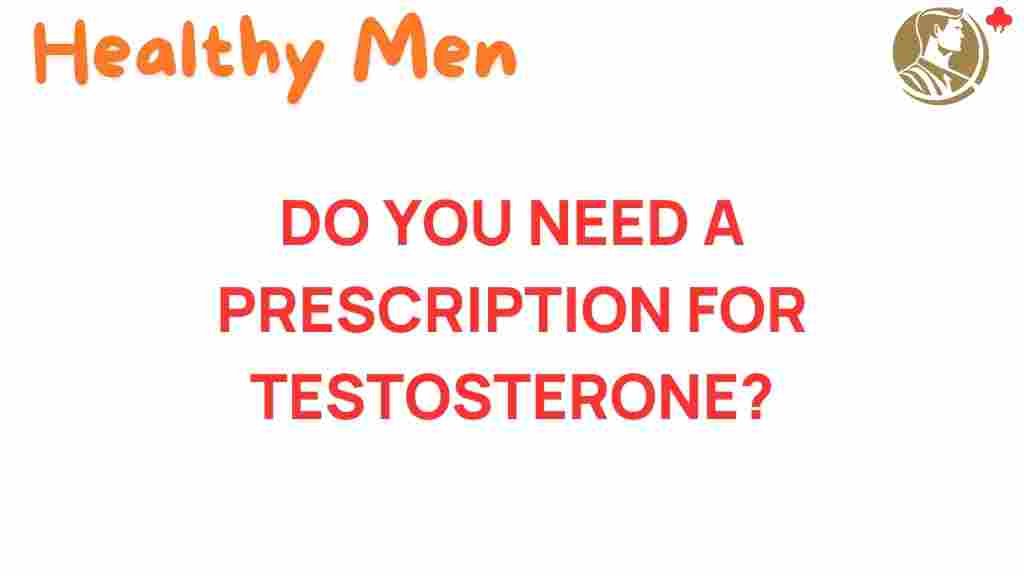The Truth Behind Testosterone: Is a Prescription Necessary?
Testosterone, a vital hormone in the body, plays a crucial role in various aspects of health and wellness, particularly in men’s health. As awareness of testosterone therapy increases, so does the debate about whether a prescription is necessary for treatment. In this article, we will explore the truth behind testosterone, the regulations surrounding its prescription, the available treatments, and valuable medical advice for those considering hormone therapy.
Understanding Testosterone: What You Need to Know
Testosterone is primarily known as the male sex hormone, but it is also present in females at lower levels. It is essential for:
- Developing male physical characteristics
- Maintaining muscle mass and strength
- Regulating libido and sexual function
- Supporting bone density
- Influencing mood and cognitive function
Low testosterone levels can lead to various health issues, including fatigue, depression, decreased libido, and loss of muscle mass. In recent years, testosterone therapy has gained popularity as a solution for these problems. However, the question remains: is a prescription necessary?
Why a Prescription for Testosterone May Be Required
Testosterone therapy is a medical treatment that can help restore hormone levels to a healthy state. However, it is essential to understand that testosterone is a controlled substance in many countries due to the potential for misuse and health risks associated with improper use.
The Risks of Self-Medicating
Many individuals consider self-medicating or obtaining testosterone through non-prescription means. This approach can be dangerous because:
- Imbalances: Incorrect dosing can lead to hormonal imbalances, causing more health issues.
- Side Effects: Unsupervised testosterone use can result in severe side effects, including cardiovascular problems, liver damage, and psychological effects.
- Legal Issues: Obtaining testosterone without a prescription can lead to legal consequences.
Because of these risks, seeking a prescription for testosterone therapy is essential. A healthcare provider can ensure that treatment is safe and effective based on individual health needs.
Regulations Surrounding Testosterone Treatment
In many countries, testosterone is classified as a controlled substance. This classification means that it can only be prescribed by a licensed medical professional. The regulations surrounding testosterone therapy are in place to protect patients from potential misuse and health complications.
Who Can Prescribe Testosterone?
Typically, the following healthcare professionals can prescribe testosterone:
- Primary care physicians
- Endocrinologists
- Urologists
- Specialists in men’s health
Before prescribing testosterone, doctors will often conduct a thorough evaluation, which may include:
- Blood tests to measure testosterone levels
- Medical history review
- Assessment of symptoms
Types of Testosterone Treatments
Once a prescription is obtained, there are several methods of testosterone therapy available:
- Injections: Testosterone can be injected intramuscularly or subcutaneously.
- Patches: Transdermal patches deliver testosterone through the skin.
- Gels: Topical gels are applied to the skin and absorbed into the bloodstream.
- Pellets: Small pellets can be implanted under the skin, releasing testosterone over time.
Each method has its pros and cons, and the best choice depends on individual preferences and medical guidance.
Step-by-Step Process of Obtaining Testosterone Therapy
If you suspect low testosterone levels, here is a step-by-step process to follow:
Step 1: Consult a Healthcare Provider
Schedule an appointment with a healthcare professional who specializes in men’s health. Discuss your symptoms and concerns regarding testosterone levels.
Step 2: Undergo Testing
Your doctor will likely order blood tests to check your testosterone levels. These tests are usually done in the morning when testosterone levels are highest.
Step 3: Review Results and Discuss Options
Once your results are in, your doctor will discuss whether testosterone therapy is appropriate for you. If so, they will explain the different treatment options available.
Step 4: Start Treatment
If you and your doctor decide on a treatment plan, you’ll begin therapy. Follow your healthcare provider’s instructions closely and schedule regular follow-ups to monitor your progress.
Step 5: Adjust as Needed
Based on your response to therapy and any side effects, your doctor may adjust your treatment plan for optimal results.
Troubleshooting Tips for Testosterone Therapy
While testosterone therapy can be highly beneficial, some individuals may experience challenges. Here are some troubleshooting tips:
Monitor Side Effects
Be aware of potential side effects such as:
- Increased aggression or mood swings
- Acne or skin reactions
- Sleep apnea
- Fluid retention
If you experience any of these, consult your healthcare provider promptly.
Regular Follow-ups
Schedule regular follow-up appointments to monitor hormone levels and overall health. This will help in making necessary adjustments to your treatment plan.
Maintain a Healthy Lifestyle
Complement your testosterone therapy with a healthy lifestyle, including:
- A balanced diet rich in nutrients
- Regular exercise
- Sufficient sleep
These lifestyle choices can enhance the effectiveness of your treatment.
Conclusion
In conclusion, testosterone therapy can be a valuable treatment for those with low testosterone levels. However, it is crucial to approach it responsibly by obtaining a prescription from a qualified healthcare professional. Self-medicating or seeking testosterone without medical oversight can lead to serious health risks and legal issues.
Before starting any treatment, always seek medical advice and have an open discussion with your healthcare provider about your symptoms, treatment options, and the regulations regarding testosterone therapy. By doing so, you can ensure a safe and effective approach to restoring your health and wellness.
For more related information on men’s health, visit our Men’s Health Resource page.
For further reading on testosterone regulations, check this external link.
This article is in the category Conditions and created by healthymen Team
